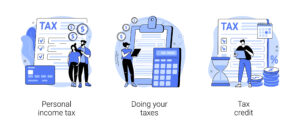Plan Now to Get Full Benefit of Saver’s Credit

Plan Now to Get Full Benefit of Saver’s Credit
Plan Now to Get Full Benefit of Saver’s Credit, Tax Break Helps Low- and Moderate-Income Workers Save for Retirement
Low- and moderate-income workers can take steps now to save for retirement and earn a special tax credit in 2007 and the years ahead, according to the Internal Revenue Service.
The saver’s credit helps offset part of the first $2,000 workers voluntarily contribute to IRAs and to 401(k) plans and similar workplace retirement programs. Formally known as the retirement savings contributions credit, the saver’s credit is available in addition to any other tax savings that apply.
“We want low- and moderate-income workers to know about this valuable credit so they can effectively plan ahead and take full advantage of it,” said Richard J. Morgante, commissioner of the Wage and Investment Division of the IRS. “Now that a growing number of employers are automatically enrolling their employees in 401(k) plans, the saver’s credit offers many workers who save for retirement an added bonus.”
Eligible workers still have time to make qualifying retirement contributions and get the saver’s credit on their 2007 tax return. People have until April 15, 2008, to set up a new individual retirement arrangement or add money to an existing IRA and still get credit for 2007. However, elective deferrals must be made by the end of the year to a 401(k) plan or similar workplace program, such as a 403(b) plan for employees of public schools and certain tax-exempt organizations, a governmental 457 plan for state or local government employees, and the Thrift Savings Plan for federal employees. Employees who are unable to set aside money for this year may want to schedule their 2008 contributions soon so their employer can begin withholding them in January.
The saver’s credit can be claimed by:
Married couples filing jointly with incomes up to $52,000 in 2007 or $53,000 in 2008;
Heads of Household with incomes up to $39,000 in 2007 or $39,750 in 2008; and
Married individuals filing separately and singles with incomes up to $26,000 in 2007 or $26,500 in 2008.
Like other tax credits, the saver’s credit can increase a taxpayer’s refund or reduce the tax owed. Though the maximum saver’s credit is $1,000, $2,000 for married couples, the IRS cautioned that it is often much less and, due in part to the impact of other deductions and credits, may, in fact, be zero for some taxpayers.
A taxpayer’s credit amount is based on his or her filing status, adjusted gross income, tax liability and amount contributed to qualifying retirement programs. Form 8880 is used to claim the saver’s credit, and its instructions have details on figuring the credit correctly.
In 2005, the most recent year for which complete figures are available, saver’s credits totaling more than $900 million were claimed on nearly 5.3 million individual income tax returns. Saver’s credits claimed on these returns averaged $216 for joint filers, $149 for heads of household and $140 for single filers.
The saver’s credit supplements other tax benefits available to people who set money aside for retirement. For example, most workers may deduct their contributions to a traditional IRA. Though Roth IRA contributions are not deductible, qualifying withdrawals, usually after retirement, are tax-free. Normally, contributions to 401(k) and similar workplace plans are not taxed until withdrawn.
Other special rules that apply to the saver’s credit include the following:
Eligible taxpayers must be at least 18 years of age.
Anyone claimed as a dependent on someone else’s return cannot take the credit.
A student cannot take the credit. A person enrolled as a full-time student during any part of 5 calendar months during the year is considered a student.
Certain retirement plan distributions reduce the contribution amount used to figure the credit. For 2007, this rule applies to distributions received after 2004 and before the due date (including extensions) of the 2007 return. Form 8880 and its instructions have details on making this computation.
Begun in 2002 as a temporary provision, the saver’s credit was made a permanent part of the tax code in legislation enacted last year. To help preserve the value of the credit, income limits are now adjusted annually to keep pace with inflation.
We hope you found this article about “Plan Now to Get Full Benefit of Saver’s Credit” helpful. If you have questions or need expert tax or family office advice that’s refreshingly objective (we never sell investments), please contact us or visit our Family office page or our website at www.GROCO.com. Unfortunately, we no longer give advice to other tax professionals gratis.
To receive our free newsletter, contact us here.
Subscribe our YouTube Channel for more updates.

Alan Olsen, is the Host of the American Dreams Show and the Managing Partner of GROCO.com. GROCO is a premier family office and tax advisory firm located in the San Francisco Bay area serving clients all over the world.
Alan L. Olsen, CPA, Wikipedia Bio

GROCO.com is a proud sponsor of The American Dreams Show.

The American Dreams show was the brainchild of Alan Olsen, CPA, MBA. It was originally created to fill a specific need; often inexperienced entrepreneurs lacked basic information about raising capital and how to successfully start a business.
Alan sincerely wanted to respond to the many requests from aspiring entrepreneurs asking for the information and introductions they needed. But he had to find a way to help in which his venture capital clients and friends would not mind.
The American Dreams show became the solution, first as a radio show and now with YouTube videos as well. Always respectful of interview guest’s time, he’s able to give access to individuals information and inspiration previously inaccessible to the first-time entrepreneurs who need it most.
They can listen to venture capitalists and successful business people explain first-hand, how they got to where they are, how to start a company, how to overcome challenges, how they see the future evolving, opportunities, work-life balance and so much more..
American Dreams discusses many topics from some of the world’s most successful individuals about their secrets to life’s success. Topics from guest have included:
Creating purpose in life / Building a foundation for their life / Solving problems / Finding fulfillment through philanthropy and service / Becoming self-reliant / Enhancing effective leadership / Balancing family and work…

MyPaths.com (Also sponsored by GROCO) provides free access to content and world-class entrepreneurs, influencers and thought leaders’ personal success stories. To help you find your path in life to true, sustainable success & happiness. It’s mission statement:
In an increasingly complex and difficult world, we hope to help you find your personal path in life and build a strong foundation by learning how others found success and happiness. True and sustainable success and happiness are different for each one of us but possible, often despite significant challenges.
Our mission at MyPaths.com is to provide resources and firsthand accounts of how others found their paths in life, so you can do the same.
IRS Notice 2009-62 Issued 8/7/09
IRS Notice 2009-62 Issued 8/7/09 The due date for reporting the existence of Offshore Bank Accounts on Treasury Department Form TD F 90-22.1 has been an issue of great confusion in the last few months. Form TD F 90-22.1 is known as Foreign Bank Account Reporting (AKA “FBAR”) For a complete review of this soap…
Income the IRS Can’t Touch
Income the IRS Can’t Touch There’s one readily available and legal source of untaxed income that we know of: municipal bonds. These securities are issued by state and local governments, school districts, hospitals and other public agencies to support community projects and services. To permit these worthy endeavors to raise money economically, Uncle Sam exempts…
Avoiding Real Estate Tax Revaluations
Avoiding Real Estate Tax Revaluations by Steven Singer, CPA As a result of the passage of Proposition 13 almost thirty years ago, real estate owners currently enjoy paying property taxes based on the property’s purchase price, value of improvements and an annual increase of 2% over the previous years’ assessed value. As a result of…
Annuities in Qualified Retirement Plans
Annuities in Qualified Retirement Plans By Russell Hill Using annuities in qualified retirement plans. Qualified annuities reduce your current taxable salary in addition to accumulating tax deferred earnings, when you contribute money to an annuities program through an employer (as one of the investment options in a salary reduction retirement plan). Those who work for…


